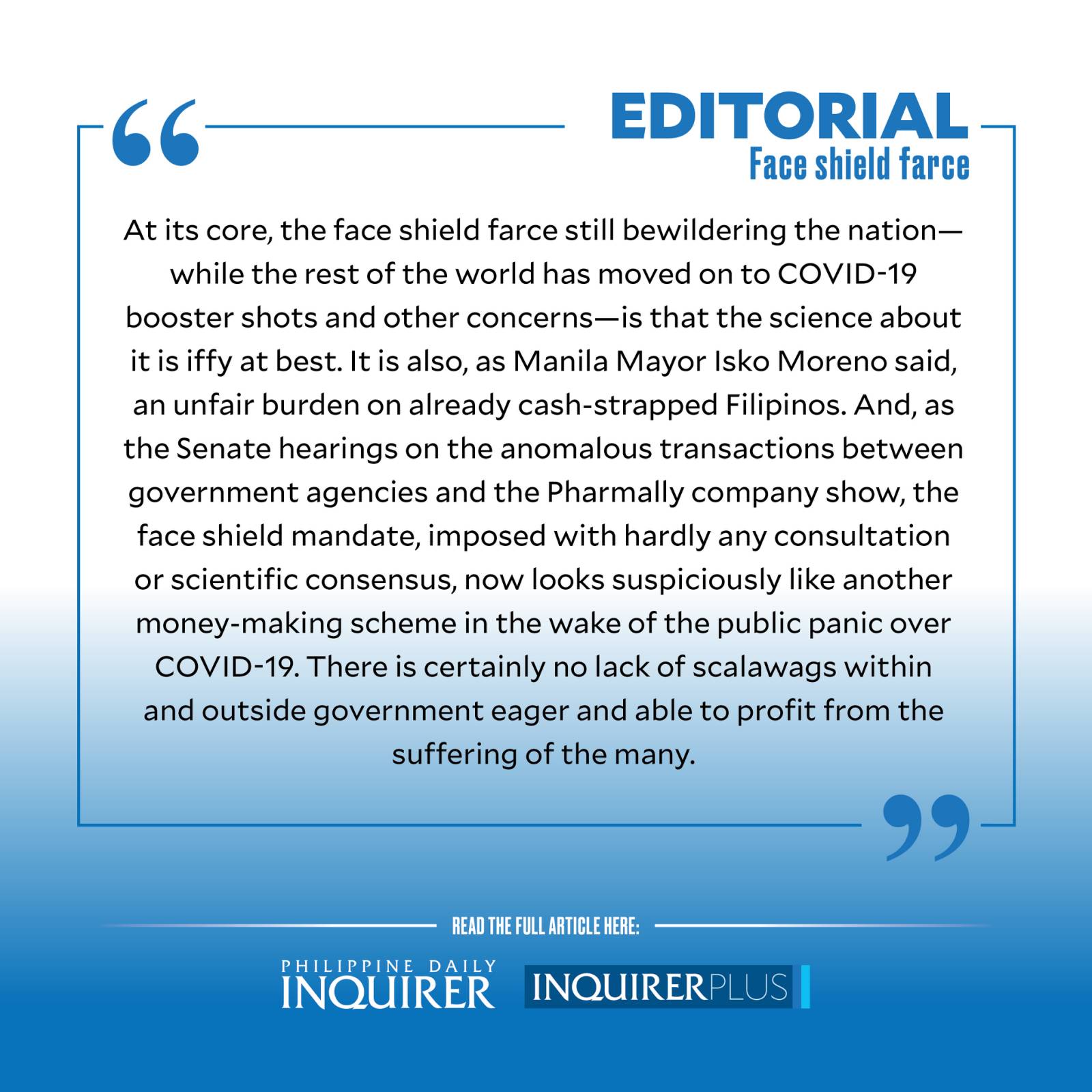Face shield farce

This issue is not worth quarreling about,” Interior Secretary Eduardo Año said early this week, at the height of the bedlam surrounding the requirement to use face shields in public places.
Face shields have been a uniquely Filipino “issue” ever since the Inter-Agency Task Force for the Management of Emerging Infectious Diseases (IATF), the country’s primary policymaking body created to deal with the local impact of the COVID-19 pandemic, imposed its use on citizens.
The use of face shields—most commonly sheets of plastic or acrylic designed to cover the face—is uniquely Filipino, because the Philippines is the only country in the world, it’s said, to make it mandatory. Health authorities claim the shield is an “added layer of protection” against infection. But there are others who warn that the shields instead “trap” microorganisms between the plastic layer and the wearer’s face, facilitating transmission.
With infection rates falling significantly in Metro Manila and other urban centers in recent days, leading to the easing of anti-COVID-19 restrictions, face shields—or rather their continued use—have become a focus of concern and disdain among both government officials and ordinary citizens.
While the national government, through the IATF, has yet to decide on whether to continue mandating the use of face shields, local government leaders have been taking matters into their own hands. Chomping at the bit to get rid of what has become a symbol of not only the suffering Filipinos have been subject to due to COVID-19, but also of the massive corruption it appears to have spawned as revealed by the Pharmally scandal, LGU executives like Manila Mayor Francisco “Isko Moreno” Domagoso and Davao City Mayor Sara Duterte have gone ahead and lifted the requirement to use face shields outside the home in their localities. Others, like San Juan Mayor Francis Zamora, have said they will wait for word from the IATF before lifting the requirement and amending current ordinances that penalize people caught “shield-less” in public.
The babel extends to officials at the national level. Año, for one, believes mayors have the power and right to lift the mandatory use of face shields even without the IATF’s approval. “It’s up to them if they decide ahead of the IATF,” Año told the media. “It’s not like before where we didn’t have vaccines yet and our cases were really high. We were really strict then.”
But Malacañang, through presidential spokesperson Harry Roque, insists that local governments should implement the face shield mandate until and unless the IATF lifts the order. Roque said LGUs should “respect the process” and wait for word from the President, adding that mayors should not decide on their own regarding the matter of face shields and other policies set at the national level. If local chief executives continue to do things on their own and defy national government policies, it could embolden the public to disobey health protocols, Roque warned (“Paano ngayon susunod ang mga mamamayan kung mga mayor mismo ay hindi sumusunod?”).
President Duterte himself, however, has aired doubts about the need for face shields. In September, he said they were now required only indoors, particularly in places with high risk of infection such as hospitals, in close quarters, and in crowded places. But because malls, markets, and public transport hubs qualify as crowded places where much of the populace congregates for their daily errands or work commute, that purported change in the directive altered nothing at all; people are still required to have their face shields with them when entering establishments and any time they are out in public.
At its core, the face shield farce still bewildering the nation—while the rest of the world has moved on to COVID-19 booster shots and other concerns— is that the science about it is iffy at best. Aerosols that transmit the virus can still penetrate openings in or created by the plastic barriers, many of which are flimsy and substandard. Compounding the problem is that the face shield not only makes it difficult to breathe, it also distorts the wearer’s vision. This has led to many users opting to raise the face shields above their foreheads, prepared to lower them only upon catching sight of a person in authority. It is also, as Moreno said, an unfair burden on already cash-strapped Filipinos.
And, as the Senate hearings on the anomalous transactions between government agencies and the Pharmally company show, the face shield mandate, imposed with hardly any consultation or scientific consensus, now looks suspiciously like another money-making scheme in the wake of the public panic over COVID-19. There is certainly no lack of scalawags within and outside government eager and able to profit from the suffering of the many.















